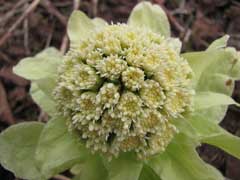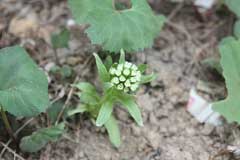 |
|
http://commons.wikimedia.org/wiki/User:Vihljun |
 |
| http://commons.wikimedia.org/wiki/User:Dalgial |
Translate this page:
Summary
Bloom Color: White. Main Bloom Time: Early spring, Late winter. Form: Spreading or horizontal, Upright or erect.
Physical Characteristics

 Petasites japonicus is a PERENNIAL growing to 0.6 m (2ft) by 1.5 m (5ft in) at a fast rate.
Petasites japonicus is a PERENNIAL growing to 0.6 m (2ft) by 1.5 m (5ft in) at a fast rate.
See above for USDA hardiness. It is hardy to UK zone 5. It is in flower in February, and the seeds ripen in March. The species is dioecious (individual flowers are either male or female, but only one sex is to be found on any one plant so both male and female plants must be grown if seed is required). and is pollinated by Insects. The plant is not self-fertile.
Suitable for: light (sandy), medium (loamy) and heavy (clay) soils. Suitable pH: mildly acid, neutral and basic (mildly alkaline) soils. It can grow in full shade (deep woodland) semi-shade (light woodland) or no shade. It prefers moist or wet soil.
UK Hardiness Map
US Hardiness Map
Synonyms
Nardosmia japonica.
Plant Habitats
Woodland Garden Sunny Edge; Dappled Shade; Shady Edge; not Deep Shade; Ground Cover; Meadow; Bog Garden;
Edible Uses
Edible Parts: Flowers Stem
Edible Uses:
Leaf stalks - cooked and used like rhubarb[1, 2, 46, 116]. The stems can be up to 1.2 metres long[104]. They can be boiled and seasoned, pickled and used in winter soups or preserved in miso[183]. They can be boiled, dipped in cold water then peeled and baked - they have a pleasant fragrant taste[206]. Flower buds cooked or used as a flavouring[1, 22, 46, 61, 105]. A slightly bitter yet agreeable flavour[116, 206], they are much prized in Japan[183]. They can be eaten whilst still green with miso or boiled down in soy sauce[183]. The young flowering stems can be eaten cooked[206].
References More on Edible Uses
| Composition
|
| Figures in grams (g) or miligrams (mg) per 100g of food.
|
|
|
Leaves (Dry weight)
|
|
- 250 Calories per 100g
- Water : 0%
- Protein: 19.5g; Fat: 2.8g; Carbohydrate: 52.8g; Fibre: 19.4g; Ash: 25g;
- Minerals - Calcium: 1194mg; Phosphorus: 556mg; Iron: 2.8mg; Magnesium: 0mg; Sodium: 917mg; Potassium: 12500mg; Zinc: 0mg;
- Vitamins - A: 278mg; Thiamine (B1): 0.56mg; Riboflavin (B2): 0.56mg; Niacin: 5.56mg; B6: 0mg; C: 56mg;
- Reference: [ ]
- Notes:
|
|
Medicinal Uses
Plants For A Future can not take any responsibility for any adverse effects from the use of plants. Always seek advice from a professional before using a plant medicinally.
Antiasthmatic Antispasmodic Expectorant Miscellany Poultice
The plant (though the exact part of the plant used is not specified) is antiasthmatic, antispasmodic, expectorant and poultice[147]. A decoction is used in the treatment of chronic coughing and pulmonary 'deficiency', laboured or difficult breathing and asthma, constant sputum formation and pulmonary tuberculosis[147].
References More on Medicinal Uses
The Bookshop: Edible Plant Books
Our Latest books on Perennial Plants For Food Forests and Permaculture Gardens in paperback or digital formats.

Edible Tropical Plants
Food Forest Plants for Hotter Conditions: 250+ Plants For Tropical Food Forests & Permaculture Gardens.
More

Edible Temperate Plants
Plants for Your Food Forest: 500 Plants for Temperate Food Forests & Permaculture Gardens.
More

More Books
PFAF have eight books available in paperback and digital formats. Browse the shop for more information.
Shop Now
Other Uses
Miscellany
The leaves of the sub-species P. japonicus giganteus are used as umbrellas by Japanese children[187]. The leaf stalks can be used as walking sticks[206]. Plants can be grown as ground cover in damp shady places[206]. They are too invasive for most gardens and should only be used where they have plenty of room[208].
Special Uses
Food Forest Ground cover
References More on Other Uses
Cultivation details
Landscape Uses:Container, Ground cover, Massing, Woodland garden. Succeeds in ordinary garden soil[1], but prefers a deep fertile humus-rich soil that is permanently moist but not stagnant, succeeding in shade, semi-shade or full sun[200]. Requires a moist shady position[187]. Plants can be grown in quite coarse grass, which can be cut annually in the autumn[233]. A very invasive plant, too rampant for anything other than the wild garden[187, 200]. Its roots are very difficult to eradicate[200]. The sub-species P. japonicus giganteus has huge leaves up to 1.5 metres across on stems 2 metres tall[187]. It has a poorer flavour than the species type[206]. Sometimes cultivated in E. Asia as a food plant[1, 58]. Dioecious, male and female plants must be grown if seed is required. Special Features:Attractive foliage, Not North American native, Invasive, Wetlands plant, Flower characteristics are unknown. Petasites japonicus giganteus (Petasites japonicus subsp. giganteus F.Schmidt ex Kitam) is a larger version of Petasites japonicus commonly know as giant fuki. It can grow in similar hardiness zones to fuki but can grow in wetter conditions and tolerate more sun. It can grow to 5 ft (1.5m). The plant is heat tolerant in zones 9 through 5. (Plant Hardiness Zones show how well plants withstand cold winter temperatures.
Plant Heat Zones show when plants would start suffering from the heat.
The Plant Heat Zone map is based on the number of "heat days" experienced in a given area where the temperature climbs to over 86 degrees F (30°C).
At this temperature, many plants begin to suffer physiological damage. Heat Zones range from 1 (no heat days) to 12 (210 or more heat days).
For example Heat Zone. 11-1 indicates that the plant is heat tolerant in zones 11 through 1.) For polyculture design as well as the above-ground architecture (form - tree, shrub etc. and size shown above) information on the habit and root pattern is also useful and given here if available. The plant growth habit is a runner spreading indefinitely by rhizomes or stolons [1-2]. The root pattern is rhizomatous with underground stems sending roots and shoots along their length [1-2].
References Carbon Farming Information and Carbon Sequestration Information
Temperature Converter
Type a value in the Celsius field to convert the value to Fahrenheit:
Fahrenheit:
The PFAF Bookshop
Plants For A Future have a number of books available in paperback and digital form. Book titles include Edible Plants, Edible Perennials, Edible Trees,Edible Shrubs, Woodland Gardening, and Temperate Food Forest Plants. Our new book is Food Forest Plants For Hotter Conditions (Tropical and Sub-Tropical).
Shop Now
Plant Propagation
Seed - we have no information on this species but suggest sowing the seed in a cold frame as soon as it is ripe or in early spring. Only just cover the seed and do not allow the compost to dry out. When they are large enough to handle, prick the seedlings out into individual pots and plant them out in the summer. Division succeeds at almost any time of the year. Very easy, larger divisions can be planted out direct into their permanent positions. We have found that it is better to pot up the smaller divisions and grow them on in light shade in a cold frame until they are well established before planting them out in late spring or early summer.
Other Names
If available other names are mentioned here
Native Range
TEMPERATE ASIA: Anhui Sheng, China, Fujian Sheng, Henan Sheng, Hokkaidô, Honshu, Hubei Sheng, Japan, Jiangsu Sheng, Jiangxi Sheng, Korea, Kurile Islands, Kyushu, Ryukyu Islands, Sakhalin, Shaanxi Sheng, Shandong Sheng, Shikoku, Sichuan Sheng, South, Zhejiang Sheng,Russian Federation.
Weed Potential
Right plant wrong place. We are currently updating this section.
Please note that a plant may be invasive in one area but may not in your area so it's worth checking.
Conservation Status
IUCN Red List of Threatened Plants Status :

Growth: S = slow M = medium F = fast. Soil: L = light (sandy) M = medium H = heavy (clay). pH: A = acid N = neutral B = basic (alkaline). Shade: F = full shade S = semi-shade N = no shade. Moisture: D = dry M = Moist We = wet Wa = water.
Now available:
Food Forest Plants for Mediterranean Conditions
350+ Perennial Plants For Mediterranean and Drier Food Forests and Permaculture Gardens.
[Paperback and eBook]
This is the third in Plants For A Future's series of plant guides for food forests tailored to
specific climate zones. Following volumes on temperate and tropical ecosystems, this book focuses
on species suited to Mediterranean conditions—regions with hot, dry summers and cool, wet winters,
often facing the added challenge of climate change.
Read More
Expert comment
Author
(Siebold.&Zucc.)Maxim.
Botanical References
58200
Links / References
For a list of references used on this page please go here
Readers comment